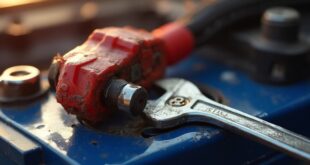Battery terminal corrosion can arise from hydrogen gas leakage, electrolyte leakage, chemical reactions in copper clamps, overcharging, and overfilling. Hydrogen gas reacts with metals, accelerating corrosion. Additionally, leaking electrolytes create a corrosive environment. Copper clamps, when subjected to electric current, can corrode over time. Overcharging generates excess heat and gas, while overfilling increases spill risks. Regular inspections and maintenance can help prevent these issues. More insights on these preventive measures are available for those interested.
Hydrogen Gas Leakage
How does hydrogen gas leakage contribute to battery terminal corrosion?
Hydrogen gas, a byproduct of battery charging, can escape from the battery and react with environmental substances. This reaction forms acids that corrode metal components, particularly at the terminals.
Over time, the accumulation of corrosion products can hinder electrical connectivity, leading to further performance issues. The corrosive effect intensifies when moisture is present, as it creates an electrolytic environment that accelerates the degradation of metal surfaces.
Regular inspection and maintenance are essential to mitigate the impact of hydrogen gas leakage and preserve the integrity of battery terminals.
Electrolyte Leakage
Electrolyte leakage is another notable contributor to battery terminal corrosion. This issue often arises due to age, damage, or overfilling of the battery.
When the electrolyte escapes, it creates a corrosive environment that can deteriorate terminal connections. To mitigate this problem, individuals should consider the following preventive measures:
- Regularly inspect batteries for signs of leakage.
- Guarantee proper filling levels to avoid overflow.
- Replace aged batteries promptly to prevent deterioration.
- Use appropriate battery types that minimize leakage risks.
Addressing electrolyte leakage can considerably enhance battery performance and longevity while reducing corrosion-related complications.
Chemical Reaction in Copper Clamps
Although battery terminals are essential for optimal vehicle performance, a chemical reaction in copper clamps can lead to considerable corrosion issues.
This reaction occurs when electric current flows through the copper, resulting in the formation of copper sulfate. Over time, this compound can accumulate, causing the clamps to corrode and deteriorate.
This corrosion not only affects the electrical connection but can also lead to battery failure if left untreated.
To mitigate this problem, using tinned copper clamps or applying protective anti-corrosive sprays can greatly enhance the durability and effectiveness of battery connections, ensuring optimal vehicle performance.
Overcharging
Corrosion issues from chemical reactions in copper clamps are often exacerbated by overcharging.
When a battery is overcharged, it can lead to excessive heat and the release of hydrogen gas, further accelerating corrosion.
To prevent overcharging and its subsequent effects, consider the following measures:
- Regularly check voltage with a multimeter, ensuring it does not exceed 14.5 volts.
- Use a smart charger that automatically adjusts charging levels.
- Monitor battery temperature during charging to prevent overheating.
- Schedule routine maintenance to identify potential issues before they escalate.
Taking these steps can greatly reduce the risk of battery terminal corrosion.
Overfilling the Battery
Overfilling a battery can lead to significant issues, including leaks and terminal corrosion.
When excess electrolyte is added, it increases the likelihood of spilling during normal operation or due to expansion from heat. This leakage can corrode battery terminals, compromising connections and overall performance.
Additionally, the corrosive nature of the electrolyte accelerates degradation of surrounding components.
To prevent overfilling, it is essential to verify if the battery is refillable and adhere to manufacturer guidelines for fluid levels.
Regular inspections can help detect any potential overfilling before it leads to more severe problems.
Proper maintenance guarantees peak battery functionality and longevity.
Frequently Asked Questions
How Can I Tell if My Battery Is Leaking?
To determine if a battery is leaking, one should inspect for visible signs of corrosion, wetness, or crusty deposits around terminals. Additionally, unusual odors or changes in battery performance may also indicate leakage.
What Tools Do I Need for Battery Maintenance?
To maintain a battery effectively, one needs essential tools such as a multimeter for voltage checks, a wrench for terminal connections, a cleaning brush, baking soda for corrosion removal, and protective gear for safety during maintenance.
Are There Specific Brands of Batteries Less Prone to Corrosion?
The inquiry about specific battery brands less prone to corrosion reveals that many reputable manufacturers incorporate advanced materials and technologies. Brands known for durability and low corrosion include Optima, Odyssey, and DieHard, favored by experts for reliability.
Can Extreme Weather Affect Battery Terminal Corrosion?
Extreme weather greatly influences battery terminal corrosion. High temperatures can accelerate chemical reactions, while cold weather may lead to condensation, both contributing to corrosion. Consequently, vehicle owners should regularly inspect terminals in varying weather conditions for ideal maintenance.
How Often Should I Check My Battery Terminals?
The frequency of checking battery terminals should ideally be every three to six months. Regular inspections help identify potential issues early, ensuring peak performance and preventing unexpected vehicle problems related to battery connectivity and corrosion.
 Car Service Land Coupons for Oil change, Tires, Wheel alignment, Brakes, Maintenance
Car Service Land Coupons for Oil change, Tires, Wheel alignment, Brakes, Maintenance




